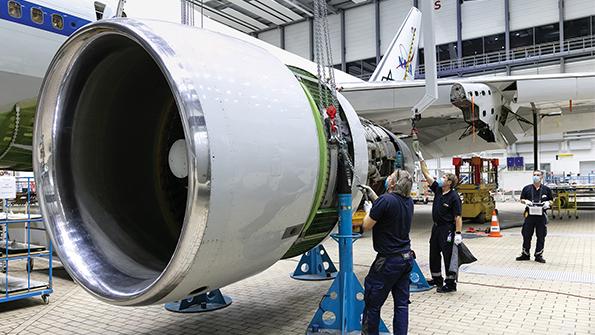
Since the launch of the Stratospheric Observatory for Infrared Astronomy (SOFIA) project, an 80-20 partnership between NASA and the German Aerospace Center, Lufthansa Technik has undertaken several scheduled maintenance tasks on the Boeing 747SP, a modified version of the widebody aircraft carrying a 17-ton telescope with a 106-in. dia. for space observation missions.
In January, Lufthansa Technik detailed the five-month-long maintenance program it was on the verge of completing on the aircraft. This latest work, an equivalent to a C check taking place every three years, began in September of last year when the aircraft flew to Germany from California, and it included a work package for the aircraft’s fuselage.
This followed two previous checks over a seven-year period at its Hamburg base. In 2014, the company had completed an extensive D check on the aircraft and followed this with a C check three years later in 2017, which was more a wing pylon and engine inspection package in accordance with NASA regulations.
While the aircraft is an older 747 (43 years old), the SP variant is unique in modern commercial aviation. Boeing built only about 40 of the aircraft, and just three remain in active service today. Taking into account its highly modified form involves both technological and structural considerations when undertaking the extended maintenance visit, which Sven Hatje, technical project manager at Lufthansa Technik, says is comparable to a C check, requiring around 16,000 labor-hours of work.
The 747SP used in the SOFIA project has around 80,000 on-wing flight hours to date and conducts about 160 astronomy-related flights a year. The maturity of the aircraft is also factored into how components are removed. “We spent a lot of time inside the cabin with the removal of the whole interior, the external fuselage, engine and landing gears—we took a lot of special care due to the age of aircraft,” Hatje says.
To inspect the internal fuselage for corrosion and cracks, Lufthansa Technik stripped out the entire cabin, including the flooring and ceilings, while NASA teams removed mission-control instruments. All four JT9D engines were removed for inspection of the whole engine, including its attachments and tubings. “SOFIA is operating to get to the maximum altitude in a short time, so the engines suffer very high loads, especially the hot sections on the JT9D, which are very different to ones found on modern aircraft,” Hatje says. “It doesn’t have turbo-case pooling, for example, so the cases are part of a very high-stress area.”
Unlike on previous checks, the 747SP’s telescope, weighing 17 tons, also underwent modifications. The telescope was overhauled by staff at the German SOFIA Institute at the University of Stuttgart, while the GREAT (German Receiver for Astronomy at Terahertz Frequencies) scientific instrument mounted on the telescope was maintained at the Max Planck Institute for Radio Astronomy in Bonn.
Processes related to the telescope’s maintenance were also refined. “During the last check, there were discrepancies about performance-improving and increased reliability of the equipment pooling of the whole aircraft, so we worked with NASA to improve the equipment-pooling system related to the telescope,” says Hatje. Certification has been completed, and results are being awaited after a test flight.
After this maintenance is finished, SOFIA will remain in Germany for six weeks, performing science observations from Cologne in February to March. Over the course of one month, SOFIA will conduct about 20 overnight research flights focusing on several observations, with some large-scale investigations rescheduled from last year owing to the COVID-19 pandemic.
While the intention is to keep the aircraft flying reliably until the conclusion of its mission in 2034, the aircraft itself could remain in service indefinitely. “There is no structural or defined end of the lifetime,” Hatje says of the aircraft. “Fuselage-wise, it’s possible to repair everything as long as you have the material . . . . The critical parts will be the engines and the component support—because it’s an SP aircraft . . . a lot of parts, especially for cabin pressurization, are unique to the aircraft.” Hatje adds that NASA prepared for the project by collecting spare parts, engines and even whole gearsets in overhaul condition.
